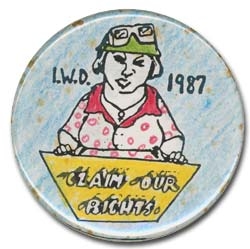
Women's Movement
Women and colonisation
Perhaps never before had the place of women been given such importance in the planning of a new province, as that which was detailed in Edward Gibbon Wakefield's systematic colonisation plans for South Australia.
To avoid the pitfalls of earlier colonial experiences Wakefield wrote, 'The transportation of at least ten males for one female, maintains a great disproportion between the sexes. This is the greatest evil of all.' [Wakefield, A letter from Sydney the principal town of Australasia, 1829, p. 108]
This perception of moral decline accompanying an imbalance of the sexes led to inclusion in the1834 South Australia Act the provision that 'Persons who shall by means of the said 'Emigration Fund' be conveyed to the said Province or Provinces shall, as afar as possible, be adult persons of the Two Sexes in equal proportions'. [An Act to empower His Majesty to erect South Australia into a British Province or Provinces and to provide for the Colonization and Government thereof, 1834, s. VI]
Social concerns were not avoided by this measure, but the proportion of women to men was considerably greater than was the case in New South Wales. The 1841 South Australian census, for example, records that of the residents of Hindley Street, 320 were male and 271 female. Of those aged between of 14 and 34 years, 84 were male and 94 were female.
Consequently, from the earliest days of the province, there existed a significant number of women and men who were conversant with ideals of religious freedom and social equity, creating a fertile environment in which social reform could develop.
The first European women to settle in South Australia were for the most part married, in accordance with the aims of the South Australia Act to have equal numbers of both sexes. However, on arrival in South Australia these women were subject to the same marriage and property laws that had disenfranchised them from owning property, or having a political voice, in England. Among these early migrant women was Helen Brodie Spence, who arrived in November 1839 aboard the Palmyra accompanied by her children, including 14 year old Catherine Helen Spence.
In Europe, the post-revolutionary era following the 19th Century industrial and economic revolutions produced an increasingly organised working class, a growing middle class and an increased demand for labour. The colonial expansion to the New World took women from their traditional roles and placed them in the labour force. Here they could earn an independent income and meet together in factory settings that permitted the exchange of ideas.
The industrial revolution also impacted on men and in 1856 South Australia became the first Australian colony to grant universal male suffrage for elections to the House of Assembly.
Items 1 - 12 of 60















